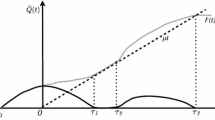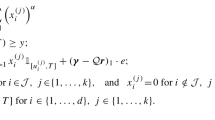Abstract
We consider a process associated with a stationary random measure, which may have infinitely many jumps in a finite interval. Such a process is a generalization of a process with a stationary embedded point process, and is applicable to fluid queues. Here, fluid queue means that customers are modeled as a continuous flow. Such models naturally arise in the study of high speed digital communication networks. We first derive the rate conservation law (RCL) for them, and then introduce a process indexed by the level of the accumulated input. This indexed process can be viewed as a continuous version of a customer characteristic of an ordinary queue, e.g., of the sojourn time. It is shown that the indexed process is stationary under a certain kind of Palm probability measure, called detailed Palm. By using this result, we consider the sojourn time processes in fluid queues. We derive the continuous version of Little's formula in our framework. We give a distributional relationship between the buffer content and the sojourn time in a fluid queue with a constant release rate.
Similar content being viewed by others
References
D. Bertsimas and D. Nakazato, The distributional Little's law and its applications, preprint (1992), to appear in Oper. Res.
P. Brémaud, An extension of Watanabe's theorem of characterization of Poisson processes over the positive real half line, J. Appl. Prob. 12 (1975) 396–399.
P. Brémaud,Point Processes and Queues: Martingale Dynamics (Springer, New York, 1981).
P. Brémaud, R. Kannurpatti and R. Mazumdar, Event and time averages: a review and some generalizations, Adv. Appl. Prob. 24 (1992) 377–411.
H. Chen and A. Mandelbaum, Discrete flow networks: Bottleneck analysis and fluid approximations, Math. Oper. Res. 16 (1991) 408–446.
D.J. Daley and D. Vere-Jones,An Introduction to the Theory of Point Processes (Springer, New York, 1988).
P. Franken, D. König, U. Arndt and V. Schmidt,Queues and Point Processes (Wiley, Chichester, 1982).
P.W. Glynn and W. Whitt, Extensions of the queueing relationsL=λW, Oper. Res. 37 (1982) 634–644.
O. Kallenberg,Random Measures (Academic Press, New York, 1983).
J. Keilson and L.D. Servi, A distributional form of Little's law, Oper. Res. Lett. 9 (1988) 239–247.
O. Kella, Parallel and tandem fluid networks with dependent Levy input, Ann. Appl. Prob. (1993), to appear.
O. Kella and W. Whitt, A tandem fluid network with Levy input, in:Queueing and Related Models, eds. U.N. Bhat and I.V. Basawa (1992) pp. 112–127.
I. Kino and M. Miyazawa, The stationary work in system of aG/G/1 gradual input queue, J. Appl. Prob. 30 (1993) 207–222.
R.M. Loynes, The stability of a queue with non-independent inter-arrival and service times, Proc. Camb. Phil. Soc. 58 (1962) 497–520.
J. Mecke, Stationäre zufällige Masse auf lokalkompakten Abelschen Gruppen, Z. Wahrscheinlich, verw. Geb. 9 (1967) 36–58.
B. Melamed and W. Whitt, On arrivals that see time averages, Oper. Res. 38 (1990) 156–172.
B. Melamed and W. Whitt, On arrivals that see time averages: A martingale approach, J. Appl. Prob. 27 (1990) 376–384.
M. Miyazawa, Time and customer processes in queues with stationary inputs, J. Appl. Prob. 14 (1977) 349–357.
M. Miyazawa, A formal approach to queueing processes in the steady state and their applications, J. Appl. Prob. 16 (1979) 332–346.
M. Miyazawa, Rate conservation law: a survey, Queueing Syst. 15 (1994) 1–58.
M. Miyazawa, Time-dependent rate conservation law for a process defined with a stationary marked point process and its applications, J. Appl. Prob. 31 (1994) 114–129.
M. Miyazawa and V. Schmidt, Risk processes with infinitely many small claims in a finite interval, in preparation (1993).
M. Miyazawa and Y. Takahashi, Rate conservation principle for discrete-time queues, Queueing Syst. 12 (1992) 215–230.
H. Pan, H. Okazaki and I. Kino, Analysis of a gradual input model for bursty traffic in ATM,Proc. ITC 13, Copenhagen (1991) pp. 795–800.
N.U. Prabhu,Stochastic Storage Processes (Springer, New York, 1980).
P. Protter,Stochastic Integration and Differential Equations (Springer, New York, 1990).
T. Rolski and S. Stidham, Jr., Continuous versions of the queueing formulasL=λW andH=λG, Oper. Res. Lett. 2 (1983) 211–215.
C. Ryll-Nardzewski, Remarks on processes of calls,Proc. 4th Berkeley Symp. on Math. Statist. Prob., vol. 2 (1961) pp. 455–465.
K. Sigman and G. Yamazaki, Fluid models with burst arrivals: a sample-path analysis, Prob. Eng. Inf. Sci. (1992) 19–27.
Y. Takahashi and M. Miyazawa, Relationship between queue-length and waiting time distributions in a priority queue with batch arrivals, Oper. Res. Soc. Japan (1993) 48–63.
W. Whitt, A review ofL=λW and extensions, Queueing Syst. 9 (1991) 235–268.
Author information
Authors and Affiliations
Rights and permissions
About this article
Cite this article
Miyazawa, M. Palm calculus for a process with a stationary random measure and its applications to fluid queues. Queueing Syst 17, 183–211 (1994). https://doi.org/10.1007/BF01158694
Received:
Revised:
Issue Date:
DOI: https://doi.org/10.1007/BF01158694




